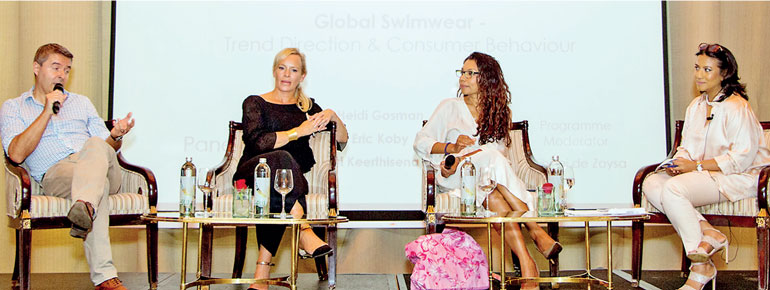Wednesday Jan 21, 2026
Wednesday Jan 21, 2026
Tuesday, 1 August 2017 00:01 - - {{hitsCtrl.values.hits}}
 In its second edition of Trendswim, the paradigm shifts strongly towards more environmentally sustainable and ethical practices in line with Swim Week Colombo’s new global positioning Green Conscious Earth Sensitive.
In its second edition of Trendswim, the paradigm shifts strongly towards more environmentally sustainable and ethical practices in line with Swim Week Colombo’s new global positioning Green Conscious Earth Sensitive.
In a series of panel discussions featuring leaders in the apparel and textile industry as well as environmental experts and artists whose work portrays the growing concerns surrounding climate change, Trendswim aims to create dialogue and engage those in the industry on best practices as well as inspire change in the way we do business. The first directional discussion focused on ‘Global Swimwear – Trend Direction and Consumer Behaviour’. The speakers were Darshi Keethisena De Livera, Eric Koby and Heidi Gosman. The session was moderated by Mihirini De Zoysa.
With the exponential growth in the global swimwear market, trends are changing at a faster pace than ever. Trendswim’s first session focussed on the key aspects surrounding this rapidly-evolving industry. Owing to this rapid globalisation of swimwear trends are changes in consumer behaviour as well as market trends. Owing to the digitalisation of marketing and global awareness, the panellists gave us an insight into globalising a luxury swimwear brand and innovation in keeping up with the ever-evolving trends.
Heidi Gosman of Heidi Klein Swimwear fame is no stranger to the global swimwear market. Starting 2002 with partner Penny Klein, with a small store in Notting Hill, Heidi Klein is now sold in over 150 stores in more than 40 countries worldwide. Eric Koby, CEO of Heidi Klein also joined the panel. Being a driving force in the global positioning of Heidi Klein as a luxury swimwear brand, Eric’s expertise truly added to the global swimwear trends panel.
Darshi Keerthisena De Livera can truly be identified as the innovator behind the Sri Lankan traditional craft of batik. Uplifting this cultural embodiment in to modern and sophisticated designs, Darshi of Buddhi Batiks continues to integrate this traditional craft into swimwear that is not only environmentally responsible but also a fusion of modern design and Sri Lankan design.
Following are excerpts of the discussion:
Q: As a global swimwear brand, how does the local environment inspire your designs and how that speaks to global fashion trends?
Heidi: People travel more and are more open to expanding their horizons. As a global brand, a lot of it is influenced by our travels; by finding means to incorporate local crafts and inspirations in our collections.
Q: Can you tell us how consumer behaviour and particularly the effects of social media and tourism on how the swimwear market, and marketing is shaped?
Eric: People are more travelled now. While working more closely with bloggers and other social media influencers, ‘Heidi Klein Escape’ was begun – take bloggers to boutique hotels and they write on the brand and the hotel. This incorporates both the tourism angle, which is a key component of the luxury swimwear industry, while marketing the brand at the same time.
Social media has completely changed our marketing strategy from the more traditional approach. While a large portion of the marketing budget is spent on digital media, channels like Instagram being very visual serves a greater purpose in marketing a swimwear brand.
Heidi: Choose your channel depending on your demographic. While certain collections are aimed at a more mature market, traditional marketing such as publications in Vogue are utilised whereas for a younger market, social media and digital marketing are the primary advertising avenues.
Eric: However, before setting on a marketing channel, do identify your market so that marketing strategies can be catered to this.
Q: In terms of how global brands penetrate and establish markets, what can you say about scalability in logistics, economics and brand presence, and the pros and cons of being a global brand?
Eric: In establishing a marketing strategy, four key aspects need to be considered – your market, your channel of distribution be it online or traditional retail, identify the key players in the industry, establish stable logistics and operational processes so that when an order is placed, no hiccups are encountered in getting your product to the customer.
Heidi: It is important that you cater to your market. Focus on individuality within each demographic.
Q: This is your third season of Buddhi Swim. What have you learnt from the past seasons, and what are you doing differently this time?
Darshi: Buddhi Swim shifts towards a more environmentally-conscious collection. Batik being a largely environmentally-degrading industry, in an effort to move away from this, we have been integrating sublimation printing which removes the necessity for water in the printing process. Furthermore, Buddhi is continuing experimentation into natural dyes – whose longevity is evident in the frescoes of Sigiriya. Additionally, a number of pieces in the collection are made from recycled PET bottle fibres. Producing at Linea Aqua, a carbon, water and biodiversity conscious production facility who has integrated sustainable practices into its operations is another effort to continue in the ethical and environmental production of swimwear.
Eric: As a global brand, it is imperative that the environmental cost of production is also considered. Including the carbon footprint associated with the garment.
